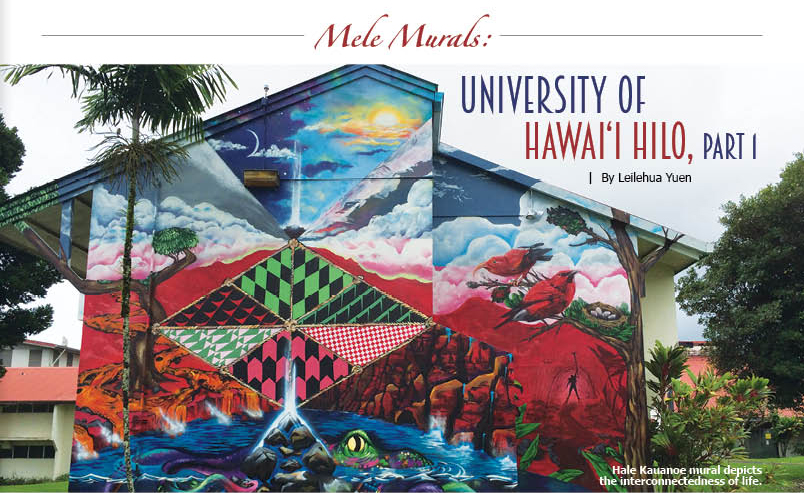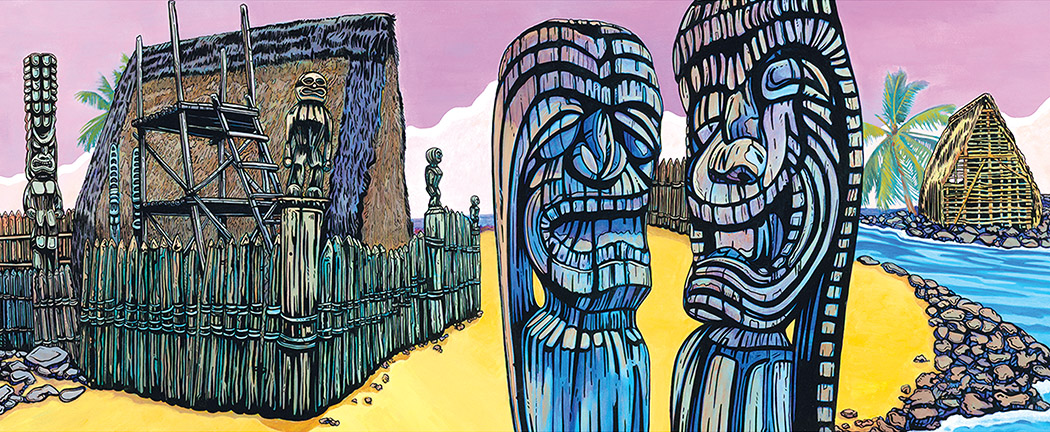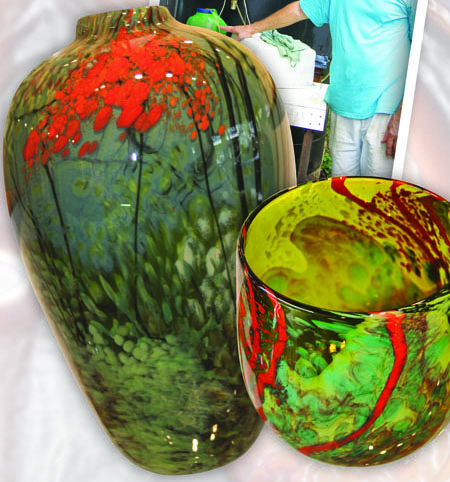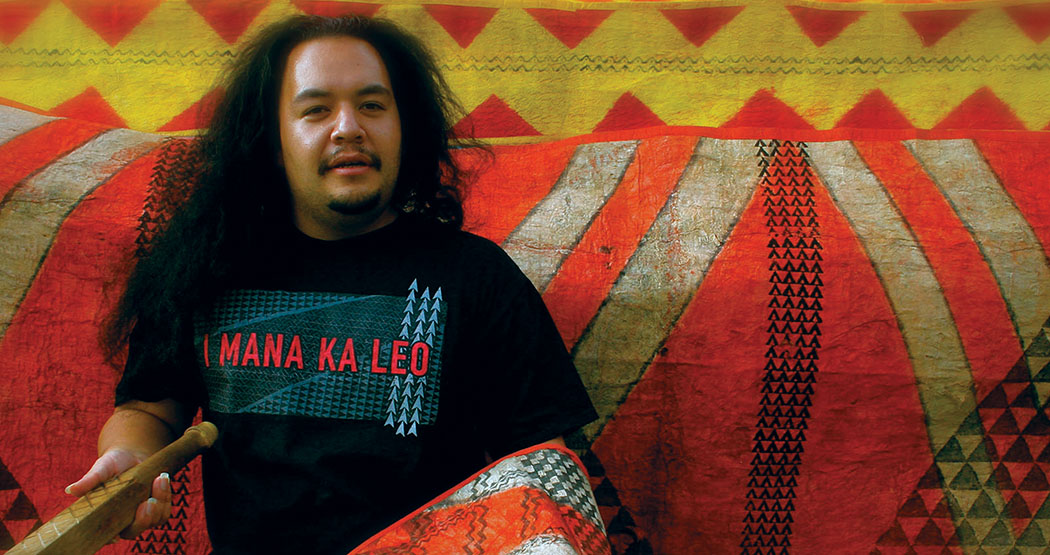
The Fabric of Community: Kapa Artist and Kumu Hula: Micah Kamohoali‘i
 By Stephanie Bolton
By Stephanie Bolton
Micah Kamohoali‘i is a professional artist who was born and raised on Hawai‘i Island. His family members are descendants of the Pele clan and the shark people of Waipi‘o Valley. He is the Executive Director for The Kamohoali‘i Foundation and Kumu Hula for Hālau Na Kipu‘upu‘u located in Waimea. An award winning Kumu, his hālau is rooted in Hawaiian culture and immersed in the traditions and old practices of the Kamohoali‘i family. He is also a Hawaiian scholar and language teacher who has taught and lectured around the world in such places as Europe, Japan, Mexico, Alaska, Canada, and Polynesia. He celebrates his rich heritage by keeping the traditional methods of creating ancient Hawaiian arts alive in their most authentic form. His ancestors were kapa people and he continues to use these old techniques to create his kapa artwork.
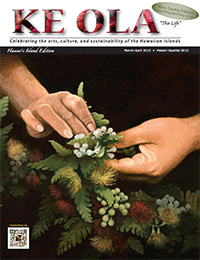
“As a people we should always progress. We should be able to do things better and faster and bigger than our ancestors to show that the family is growing and progressing. It is in this spirit that I made my huge 7-by-11 foot kapa called Kihawahine.
My family are kapa people and so I visited my aunty Malia Solomonʻs pieces that hang at the Hualālai Ballroom at the Four Seasons Resort Hualālai and measured how large hers were. They were about 6-by-10 feet, so I decided to make mine bigger by a foot in each direction.” Micah tells me. He goes on to explain that he modeled the design after the kapa used to catch each infant who was born into the family. This kapa, now very worn and over a hundred years old, would be taken out at the birth of each child so everyone in the family was caught on this same fabric.
Kapa—a fabric made by native Hawaiians from the bast fibers of certain species of trees and in shrubs in the order of Rosales and Malvales. It is similar to tapa found elsewhere in Polynesia, however it differs in the methods used for its creation.
“In, say Samoa, they will pound out sheets and then glue them together with pia (an arrowroot paste) and these pieces will overlap creating a larger piece. The Hawaiian method is different in that Hawaiians would smash, fold, and beat out a seamless piece,” Micah explains as he shows a group of volunteers how to make kapa. He takes us step by step through each part of the laborious process.
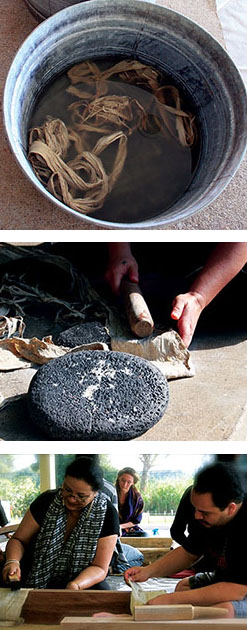
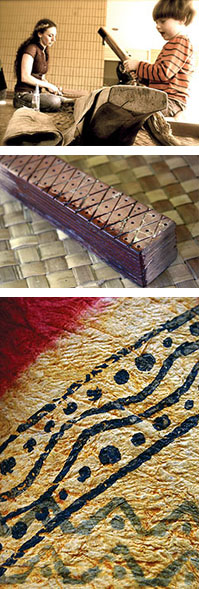
First the tree is harvested and the bark is scraped off using a ‘opihi shell until white. A shark tooth knife is then used to score and peel off the next layer from the core of the plant. This layer will then soak for a week or so until it is pliable and no longer stiff [Fig. 1]. It will then be beaten on a lava stone [Fig. 2]. Next it will be beaten on a wooden anvil until it is very thin [Fig. 3]. Another thin layer is added and pounded into the first with the grooved wooden mallet called an i‘e kuku [Fig. 4]. It will then be folded into thirds and beaten again. The kapa continues to grow as more pieces are pounded into it and folded over… like kneading dough.
Eventually the kapa is the size desired and soft like cotton. The last beating will be done with a i‘e kuku that has a specific design carved into its side and this design will leave a watermark impression in the fabric that can be clearly seen when held up to the light. Since every family had their own design, it was easy to tell whom the fabric belonged to by looking at this design [Fig. 5]. The fabric could lastly be dyed and stamped with meaningful patterns [Fig. 6].
“The dyes that I use for my artwork are all natural dyes from local plants. I do not use any modern methods to make these pieces; they are all made in the old style,” shares Micah as he discusses the inspiration for a series of kapa paintings he created to represent Hawaiian deities. “I was inspired to use only the plants and things that represent each god to dye each piece because there are certain plants associated with certain gods. For instance, the kapa for Pele was dyed with pig’s blood and the designs were stamped on with charcoal made from burnt plant ashes mixed with coconut milk.”
 The markings signify different things.
The markings signify different things.
“Rain is Lono’s body form and Lono is the god of fertility and agriculture. So these designs that stream downward at diagonal angles represent the rain on the kapa for Lono. On the kapa for Kū, the god of war, there is the pattern of breadfruit and these spearhead designs to represent schools of fish,” he explained, “And for the goddess Haumea who gave birth to the islands, I split the kapa down the middle to represent the birth canal from which the islands were born. So you can see every part of the kapa is very symbolic.”
Micah continues, “Kapa was used for clothing, for blankets… it was their fabric. So it had to be pounded out every day. Everyday there would be women pounding kapa for their families. And as you’ll notice, the anvils were hollowed out so that they serve duel purpose as a drum for what I call Hawaiian Morse code. As the ladies were pounding they could pound out a specific rhythm to tell the women in the next village that there was going to be a performance or if there was danger, because the pounding could be heard for miles away.”
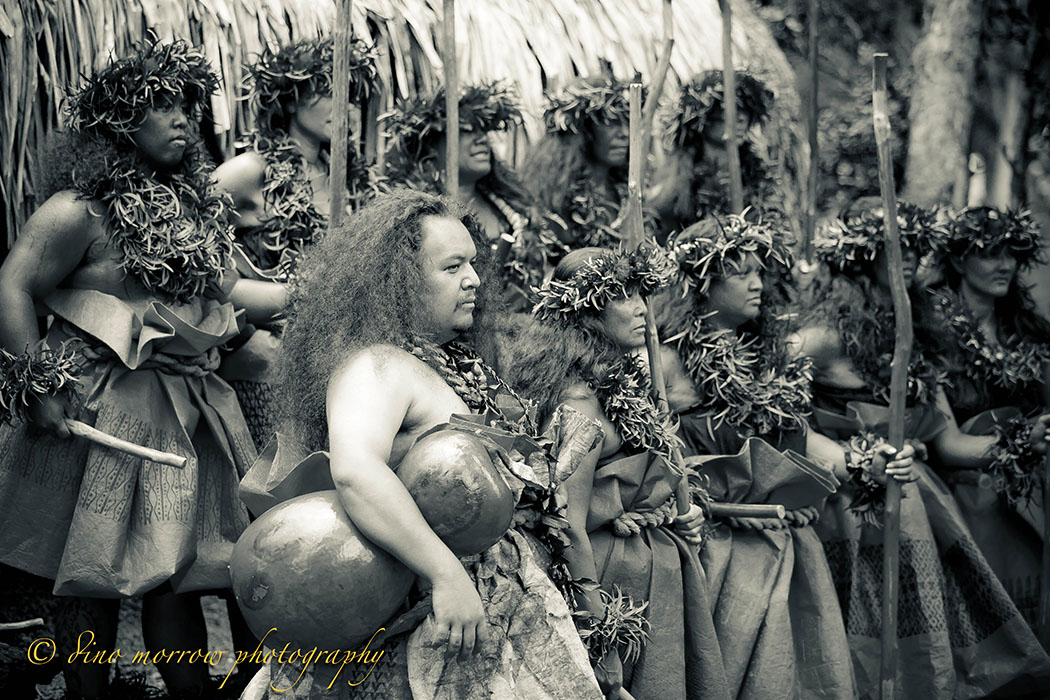 In March 2010 Micah’s hālau, Na Kipu‘upu‘u, received highly acclaimed honors from the state of Hawai‘i for their hula drama entitled “Mauliauhonua” about the descendants of Waipi‘o Valley. Micah is orchestrating an upcoming big community project with the help of volunteers.
In March 2010 Micah’s hālau, Na Kipu‘upu‘u, received highly acclaimed honors from the state of Hawai‘i for their hula drama entitled “Mauliauhonua” about the descendants of Waipi‘o Valley. Micah is orchestrating an upcoming big community project with the help of volunteers.
“This project is about bringing the community together in Waimea,” Micah shared. “I saw a segregation between the malihini (newcomers) and the Native Hawaiian people. So I wrote a grant asking to interweave everyone together because this is not about race. We are all residents of Waimea. We offered classes to celebrate the sacred sites in Waimea, taking groups from one side of Waimea all the way to the other to teach them the history about these places. We had more than 100 at each workshop where we partnered the stories with an art. After hearing the story of kapa, they learned how to make it so that they could be proud to be a part of the story of Waimea. We went to the pu‘u and talked about the battles that took place there between Hawai‘i island and Maui, discussed the strategies of battle and why they battled. Then we made dog tooth shin guards called kupe‘e niho ‘ilio. Each shin guard has around 500 canine teeth lashed together. Warriors would wear these to invoke the ferocious spirit of the dog for their fight.”
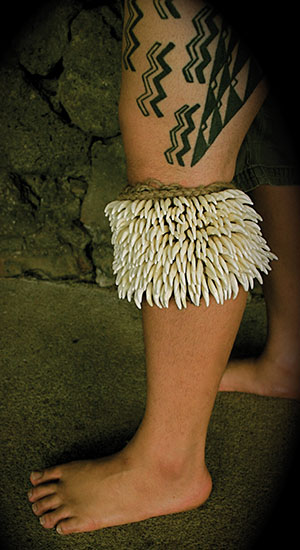 From January until March Micah’s hālau will be creating a hula drama that will be performed at the Kahilu theater the week before the Merrie Monarch Festival. “This hula drama is how we are getting the community to present these stories. It begins with the birth of the mountains and then the deities get placed on the mountains, who marry Waimea chiefs and so the people of Waimea are the descendants of these goddesses of the mountains.”
From January until March Micah’s hālau will be creating a hula drama that will be performed at the Kahilu theater the week before the Merrie Monarch Festival. “This hula drama is how we are getting the community to present these stories. It begins with the birth of the mountains and then the deities get placed on the mountains, who marry Waimea chiefs and so the people of Waimea are the descendants of these goddesses of the mountains.”
This presentation is going to be accompanied by an art exhibit of Micah’s kapa artwork and of all of the things that the community helped to make. This art exhibit is the only venue currently showcasing Micah’s artwork as he has pulled all of his work from the galleries they were in to show his collection in its entirety for this special event.
The show will use nothing modern. Every costume and prop will be something that was created in the traditional methods by the people of Waimea. “I think this hula drama is going to blow everything out of the water. It will be like using artifacts from the Bishop Museum and watching them come to life, used as they were originally intended. Some of these things have not been created for hundreds of years and so we will really get to experience traveling back in time.”
I was excited to learn that the kapa I helped pound will be a part of one of the dresses worn by a hula dancer in the show. Micah’s hālau is one of the only—if not the only hālau—that performs in kapa made exclusively for each dancer, a manner that hasn’t been done for nearly 200 years. The show is projected to take place at Kahilu Theater Spring 2013. ❖

To reserve tickets: KahiluTheater.org, 808.885.6868
Contact Micah Kamohoali‘i: 808.960.1900, micahkamohoalii@gmail.com
Contact photographer Braylene Jones: 808.896.9967, jbraylene@hotmail.com
Contact writer Stephanie Bolton: StephanieBolton.com
